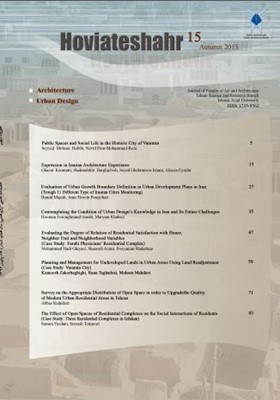Planning and Management for Undeveloped Lands in Urban Areas Using Land Readjustment (Case Study: Varamin City)
Subject Areas : architectureKianoosh Zakerhaghighi 1 , Rana Taghadosi 2 , Mohsen Mahdavi 3
1 - Assistant Professor, Hamedan Branch, Islamic Azad University, Hamedan, Iran
2 - Urban and Regional Planning (M.Sc), School of Urban Planning, University College of Fine Arts, University of Tehran
3 - Assistant Professor, Hamedan Branch, Islamic Azad University, Hamedan, Iran
Keywords: Land Readjustment Program, Valuation, New Layout, Varamin City,
Abstract :
Land Readjustment (LR) is one of the effective land acquisition methods. This method is used for developing and improving urban infrastructure. It also enhances utility and value of land, so Land Readjustment is not a land acquisition method, but a kind of land consolidation method. Implementation of a Land Readjustment project, in certain areas, is accomplished by installing urban infrastructure by means of the land contribution of public facilities, according to a layout plan. On the other hand, it helps in financing project costs by allocating some central rearranged parcels for commercial land uses. In this method, rearrangement of all parcels has been made according to a new layout and land use plan and therefore, all land rights are legally transferred to the new parcels. The aim of this article is to present a practical method in land development management for managing urban development process. Hence, Land Readjustment Program (LRP) as chosen land development management tool in urban area, is presented. First, according to global experience and literature review, different context of its use is considered and effective pattern according to Iranian cities situation is proposed and will be examined in Varamin city. For this purpose, article investigate in Land Readjustment Program experiences in other countries to find suitable criteria for evaluate value of land before and after implementation of this program. Literature review shows that there are universal criteria for this program. These criteria include plot form, plot width, distance to religious place, distance to school, distance to park, distance to commercial facilities, position of plot in its’ block, permissible density, position of plot to arterial street, and infrastructure facilities like water pipes. Then, these criteria were evaluated by experts according to their importance in the program. For valuation of plots, these criteria were used. The main principle of valuation of plots was that value of each plot before and after implementation of Land Readjustment Program is remained equal, by which every owner could receive same benefit from his plot after implementation. For calculating this nominal value of plots, the article used an equation which was presented by other experts. Whole value of each plot include an equation in which three main index were used, namely plot area, value of each criteria, and weight of each criteria. By calculating this equation for each plot and summation for every plot, value of plots could be presented in a practical way. The results of this study show that by utilization of Land Readjustment Program as an administrative tool, it is possible to redeveloping and rearranging urban areas in according to urban needs. It modifies streets network so effective accessibility to parcels will be provided and also secure service provisions for parcels. In this way, infill development of city will be ascertained. Also people participation and especially stakeholders' participation, as the main principle of new paradigms of urban theory and practice, will be provided by attracting effective groups in plan implementation. Finally, Land Readjustment Program will incresae effectiveness of urban development plans.
_||_


